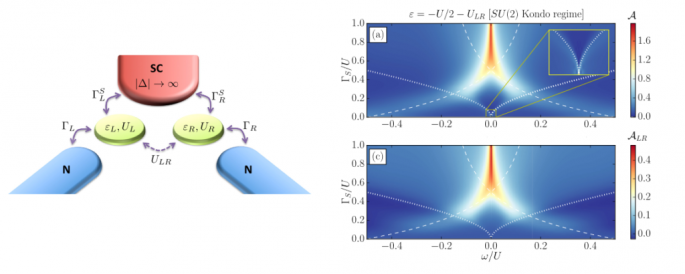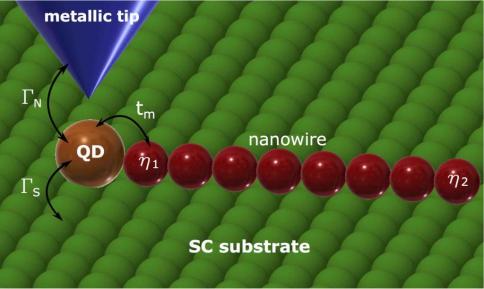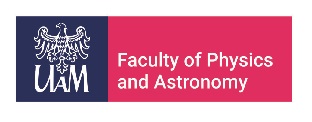Transport through quantum dots
Since the second half of 80’s, quantum dot systems has been extensively studied worldwide, both theoretically and experimentally, proving to be a convenient playground for explorations of the fundamental physical phenomena at the nanoscale. Nowadays, while we are inevitably approaching the end of the miniaturization era in the traditional electronics, these ultra-small devices pave the way into the quantum world and give a prospect of potential applications in modern nanoelectronics, spintronics and information processing technology.
Electron spin degree of freedom is a central concept in our research. The studies are focused on the theoretical description of charge and spin transport properties of a low-dimensional structures like quantum dots systems, single atoms and molecules. We analyze both equilibrium and non-equilibrium regimes, thermal transport and diverse time-dependent phenomena. In particular we are attracted to following aspects of transport through quantum dot systems:
The Kondo effect in quantum dots
The Kondo effect is a phenomenon discovered in the 1930s manifested by a minimum in dependence of electrical resistance in bulk metals. It was explained by considering the scattering of the conduction electrons on the magnetic impurities. Notably, this effect is also present in quantum dot systems and is responsible for a strong zero-bias peak in conductance. The interplay and coexistence of this truly many-body effect with other correlations is nowadays crucial topic of theoretical and experimental solid-state research, while quantum dots are perfect playground to tackle this challenge.

- J. Kondo, Resistance Minimum in Dilute Magnetic Alloys, Prog. Teor. Phys. 32, 37 (1964).
- A. C. Hewson, The Kondo Problem to Heavy Fermions (Cambridge University Press, Cambridge, U.K., 1993).
- D. Goldhaber-Gordon et al. Kondo effect in a single-electron transistor, Nature (London) 391, 156 (1998).
- J. Martinek, Y. Utsumi, H. Imamura, J. Barnaś, S. Maekawa, J. König, and G. Schön, Kondo Effect in Quantum Dots Coupled to Ferromagnetic Leads, Phys. Rev. Lett. 91, 127203 (2003).
Quantum dot spin valves
Quantum dots coupled to ferromagnetic leads and single-molecule magnets have promising magneto-transport properties, very similar to archetypical spin valve devices. A quantum dot spin-valve can generate, filter and measure spin currents, while being highly effective and under precise control by a fine-tuning through electric gates. The exploration of this systems is of fundamental meaning for novel spintronics applications.
- W. Rudziński and J. Barnaś, Tunnel magnetoresistance in ferromagnetic junctions: Tunneling through a single discrete level, Phys. Rev. B 64, 085318 (2001).
- Jürgen König and Jan Martinek, Interaction-Driven Spin Precession in Quantum-Dot Spin Valves, Phys. Rev. Lett. 90, 166602 (2003).
- Ireneusz Weymann, Jürgen König, Jan Martinek, Józef Barnaś, and Gerd Schön, Tunnel magnetoresistance of quantum dots coupled to ferromagnetic leads in the sequential and cotunneling regimes, Phys. Rev. B 72, 115334 (2005).
- N. M. Gergs, S. A. Bender, R. A. Duine, and D. Schuricht, Spin Switching via Quantum Dot Spin Valves, Phys. Rev. Lett. 120, 017701 (2018).
- Bordoloi, A., Zannier, V., Sorba, L. et al. A double quantum dot spin valve. Commun Phys 3, 135 (2020).
Hybrid quantum dot systems
Proximity effect of superconducting lead is responsible for the presence of superconducting correlations, leakage of Cooper pairs and formation of the bound states in the hybrid quantum dot systems. Transport properties are governed by Andreev reflection processes and as a consequence a diversity of new phenomena are revealed, like zero-bias anomaly, triplet blockade and splitting of entangled pairs. This very last possibility is in particular important for spin-based quantum computing, as efficient generation of non-local pairs and entanglement detection are sought features in this class of quantum devices.

- Hofstetter, L., Csonka, S., Nygård, J. & Schönenberger, C. Cooper pairsplitter realized in a two-quantum-dot y-junction. Nature461, 960–963(2009).
- De Franceschi, S., Kouwenhoven, L., Schönenberger, C. et al. Hybrid superconductor–quantum dot devices. Nature Nanotech 5, 703–711 (2010).
Majorana fermions
These elusive particles were predicted theoretically by Ettore Majorana in 1937, however only in recent years it is anticipated to uncover their presence in solid state systems. In particular, topologically protected states with Majorana-like properties can emerge at the edges of topological superconducting nanowire. One of the promising idea to identify these states is by attaching the quantum dot system to the end of the nanowire hosting Majorana edge state and perform a transport spectroscopy. Additionally, the leakage of Majorana mode into quantum dot system may results in diversity of novel effects and non-trivial interplay with Kondo physics. Our investigations in this area are dedicated to understand the rich physics of Majorana in nanoscopic systems and push progress toward taking advantage of topological states in spintronic devices and in quantum computation.

- J. Alicea, New directions in the pursuit of Majorana fermions in solid state systems, Rep. Prog. Phys. 75, 076501 (2012).
- Deng, M. T. et al. Majorana bound state in a coupled quantum-dot hybrid-nanowire system. Science 354, 1557–1562 (2016).
Dynamics at the nanoscale
Recent progress in nanofabrication techniques and quantum metrology is fueling the increasing number of experiments that are successfully capturing the dynamics in the quantum systems. Alongside, the advances of precise theoretical description are required. Due to the presence of strong electron correlations and complexity of examined systems, applied methods are often using many approximations and are computationally very demanding. The development, implementation and application of advanced methods and techniques to conveniently study the dynamics at the nanoscale is one of the ambitious goal undertaken by our group.
- Elzerman, J., Hanson, R., Willems van Beveren, L. et al. Single-shot read-out of an individual electron spin in a quantum dot. Nature 430, 431–435 (2004).
- J.R. Petta et al., Coherent manipulation of Coupled Electron Spins in Semiconductor Quantum Dots, Science 309, 2180 (2005).
- S. Loth et al., Measurement of Fast Electron Spin Relaxation Times with Atomic Resolution, Science 329, 1628 (2010).
- Latta, C., Haupt, F., Hanl, M. et al. Quantum quench of Kondo correlations in optical absorption. Nature 474, 627–630 (2011).
The above-listed objectives are pursued with the aid of modern theoretical approaches like non-equilibrium Green’s functions, density-matrix numerical renormalization group, tensor network formalism, real-time diagrammatic technique and quantum master equation.

